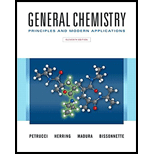
Concept explainers
Balance the following equations by inspection.
a.
b.
c.
d.
(a)
Interpretation:
Balance the following reaction by using inspection method.
Concept introduction:
Points for balancing the chemical equation:
- First, balance an element which occurs in only one compound present on both sides of the equation. Use fractions if required to balance an element.
- Then balance the atoms of element present in more amounts.
- In order to make fractions into whole number, use multiplication with suitable coefficient.
Answer to Problem 1E
The balanced equation is
Explanation of Solution
Given information:
The given equation is
Since, less number of atoms of sulfur is present in the equation so first balance sulfur atoms.
As per equation, number of sulfur atoms is equal on both sides.
Now, balance number of oxygen atoms.
To balance the oxygen atoms, multiply the oxygen molecule with half.
Multiply the whole equation with “2” to get co-efficient in whole number.
2× [
Thus, balanced equation is given by:
(b)
Interpretation:
Balance the following reaction by using inspection method.
Concept introduction:
Points for balancing the chemical equation:
- First, balance an element which occurs in only one compound present on both sides of the equation. Use fractions if required to balance an element.
- Then balance the atoms of element present in more amounts.
- In order to make fractions into whole number, use multiplication with suitable coefficient.
Answer to Problem 1E
The balanced chemical equation is:
Explanation of Solution
Given information:
The given equation is:
The more complex compound is Cl2O7, which has less common chlorine atom in it. So, balance chlorine atoms first.
The reactant side has two chlorine atoms and product has one chlorine atoms, so multiply
The above equation is balanced as number of oxygen and hydrogen atoms are equal on both sides.
(c)
Interpretation:
Balance the following reaction by using inspection method.
Concept introduction:
Points for balancing the chemical equation:
- First, balance an element which occurs in only one compound present on both sides of the equation. Use fractions if required to balance an element.
- Then balance the atoms of element present in more amounts.
- In order to make fractions into whole number, use multiplication with suitable coefficient.
Answer to Problem 1E
The balanced chemical equation is:
Explanation of Solution
Given information:
The given equation is
Since, least common atom is hydrogen atom so, first balance it on both the sides.
To balance hydrogen atoms, multiply
Now, balance the number of nitrogen atoms on both the sides by multiplying
Thus, above equation is balanced.
(d)
Interpretation:
Balance the following reaction by using inspection method.
Concept introduction:
Points for balancing the chemical equation:
- First, balance an element which occurs in only one compound present on both sides of the equation. Use fractions if required to balance an element.
- Then balance the atoms of element present in more amounts.
- In order to make fractions into whole number, use multiplication with suitable coefficient.
Answer to Problem 1E
The balanced equation is
Explanation of Solution
Given information:
The given equation is
The least common atom is chlorine so; first balance it on both sides.
To balance chlorine atoms, multiply
Now, balance hydrogen on both the sides by multiplying
Thus, above equation is balanced.
Want to see more full solutions like this?
Chapter 4 Solutions
GENERAL CHEMISTRY(LL)-W/MASTERINGCHEM.
Additional Science Textbook Solutions
Biological Science (6th Edition)
Introductory Chemistry (6th Edition)
Anatomy & Physiology (6th Edition)
Microbiology: An Introduction
Brock Biology of Microorganisms (15th Edition)
Microbiology: An Introduction
- Nonearrow_forward3. A molecular form of "dicarbon", C2, can be generated in gas phase. Its bond dissociation energy has been determined at 599 kJ/mol. Use molecular orbital theory to explain why energy of dissociation for C₂+ is 513 kJ/mol, and that for C2² is 818 kJ/mol. (10 points)arrow_forward9.73 g of lead(IV) chloride contains enough Cl- ions to make ____ g of magnesium chloride.arrow_forward
- 6. a) C2's. Phosphorus pentafluoride PF5 belongs to D3h symmetry group. Draw the structure of the molecule, identify principal axis of rotation and perpendicular (4 points) b) assume that the principal axis of rotation is aligned with z axis, assign symmetry labels (such as a1, b2, etc.) to the following atomic orbitals of the P atom. (character table for this group is included in the Supplemental material). 3s 3pz (6 points) 3dz²arrow_forward2. Construct Lewis-dot structures, and draw VESPR models for the ions listed below. a) SiF5 (4 points) b) IOF4 (4 points)arrow_forward5. Complex anion [AuCl2]¯ belongs to Doh symmetry point group. What is the shape of this ion? (4 points)arrow_forward
- 4. Assign the following molecules to proper point groups: Pyridine N 1,3,5-triazine N Narrow_forward7. a) Under normal conditions (room temperature & atmospheric pressure) potassium assumes bcc lattice. Atomic radius for 12-coordinate K atom is listed as 235 pm. What is the radius of potassium atom under normal conditions? (3 points) b) Titanium metal crystallyzes in hcp lattice. Under proper conditions nitrogen can be absorbed into the lattice of titanium resulting in an alloy of stoichiometry TiNo.2. Is this compound likely to be a substitutional or an interstitial alloy? (Radius of Ti (12-coordinate) is 147 pm; radius of N atom is 75 pm. (3 points)arrow_forwardcan someone answer the questions and draw out the complete mechanismarrow_forward
 ChemistryChemistryISBN:9781305957404Author:Steven S. Zumdahl, Susan A. Zumdahl, Donald J. DeCostePublisher:Cengage Learning
ChemistryChemistryISBN:9781305957404Author:Steven S. Zumdahl, Susan A. Zumdahl, Donald J. DeCostePublisher:Cengage Learning
 Chemistry: An Atoms First ApproachChemistryISBN:9781305079243Author:Steven S. Zumdahl, Susan A. ZumdahlPublisher:Cengage Learning
Chemistry: An Atoms First ApproachChemistryISBN:9781305079243Author:Steven S. Zumdahl, Susan A. ZumdahlPublisher:Cengage Learning Chemistry & Chemical ReactivityChemistryISBN:9781337399074Author:John C. Kotz, Paul M. Treichel, John Townsend, David TreichelPublisher:Cengage Learning
Chemistry & Chemical ReactivityChemistryISBN:9781337399074Author:John C. Kotz, Paul M. Treichel, John Townsend, David TreichelPublisher:Cengage Learning Chemistry for Engineering StudentsChemistryISBN:9781337398909Author:Lawrence S. Brown, Tom HolmePublisher:Cengage Learning
Chemistry for Engineering StudentsChemistryISBN:9781337398909Author:Lawrence S. Brown, Tom HolmePublisher:Cengage Learning Chemistry: The Molecular ScienceChemistryISBN:9781285199047Author:John W. Moore, Conrad L. StanitskiPublisher:Cengage Learning
Chemistry: The Molecular ScienceChemistryISBN:9781285199047Author:John W. Moore, Conrad L. StanitskiPublisher:Cengage Learning





